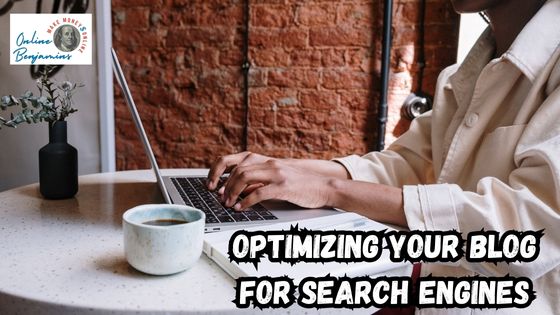SEO remains a practical way for bloggers to reach wider audiences. Optimizing your blog for search engines helps readers find your content easily. In this article, I explain the basics of SEO and share strategies that can improve your blog’s performance online.
QUICK LOOK: – Optimizing Your Blog for Search Engines
- Perform Keyword Research: Identify the keywords that fit your content and audience using reliable research tools.
- Title and Meta Description: Craft a title that includes your primary keyword and write a meta description that summarizes your post, including relevant terms.
- Organize Your Content: Use headings and subheadings to break up the text, making it easier to read for humans and search engines.
- Optimize Images: Ensure all images are compressed for web use and include keyword-rich alt text.
- Link Internally and Externally: Connect your content with other posts on your blog and authoritative external websites.
- Focus on Long-Tail Keywords: These phrases drive more targeted traffic. Although they may have lower search volume, they attract readers with specific interests. I incorporate long-tail keywords into headers and content explanations.
- Improve User Engagement: Bringing interactive elements and clear calls-to-action helps improve the time visitors spend on your site. This behavior signals to search engines that your content is valuable.
- Optimize for Voice Search: With more users employing voice search, I adjust my content style to answer questions directly. This may involve using natural language and addressing common questions in a concise manner.
- First, maintaining content readability by using clear language and short paragraphs helps readers and signals quality to search engines.
- Second, ensuring page speed is very important. Frequent review of loading times and making adjustments like stepping up image compression contributes to faster pages.
- Third, staying updated on the latest SEO trends is essential; search rules change over time, so I regularly check in with updates from trusted sources.
- Lastly, mobile optimization is critical. With increasing mobile traffic, it is important that your site functions well on smaller devices.
Essential SEO Strategies for Optimizing Your Blog
Successful SEO begins with understanding the search behavior of your target audience. Keyword research is one of the first steps. I use tools like Google Keyword Planner and other reputable sources to learn which terms readers use most often when looking for blog content in my niche. By identifying relevant keywords, I can integrate them naturally into titles, meta descriptions, and throughout the content.
Another good technique is ensuring that the title of your blog post is clear and includes your primary keyword. This helps both search engines and potential readers understand the focus of your article at a glance. A well-crafted title not only guides algorithms but also encourages clicks when the post appears in search results.
Building quality content is important for improving search rankings. I write content that is clear, engaging, and informative. This approach provides a better user experience and builds credibility over time. Including internal and external links in your posts also signals search engines about the legitimacy and depth of your content.
Preparing Your Blog for SEO Success
Before you start publishing new content, it is important to set up your blog in a way that supports your SEO efforts. Organizing your site with a clear structure makes it easier for both search engines and visitors to navigate. I make sure to use descriptive headings with proper hierarchy in every post.
Using a friendly and responsive design not only helps with user experience but also steps up page speed. Fast-loading pages improve engagement and can influence how search engines rank your site. I choose themes and plugins that are optimized for performance and carry out regular checks using tools available online.
To get the most out of your images, I optimize them for the web. This means compressing files to reduce page load times while retaining quality, and adding descriptive alt text. Including keywords in the alt text helps search engines understand the context of an image, even without seeing it.
It is also helpful to review the URL structure of your posts. I keep URLs simple, concise, and relevant to the blog post content. A clear URL structure not only benefits search engines but also improves user trust when they click on links in search results.
Quick Guide to SEO for Optimizing Your Blog
Getting started with SEO optimization need not be overwhelming. I recommend following a short checklist to ensure you cover the basic requirements for a search engine friendly blog post. The following guide outlines the major steps:
- Perform Keyword Research: Identify the keywords that fit your content and audience using reliable research tools.
- Title and Meta Description: Craft a title that includes your primary keyword and write a meta description that summarizes your post, including relevant terms.
- Organize Your Content: Use headings and subheadings to break up the text, making it easier to read for humans and search engines.
- Optimize Images: Ensure all images are compressed for web use and include keyword-rich alt text.
- Link Internally and Externally: Connect your content with other posts on your blog and authoritative external websites.
This checklist serves as a simple reference to optimize your blog posts gradually. It ensures that each very important factor is checked before publishing your work online.
Common Challenges in SEO for Optimizing Your Blog
SEO is not without challenges. There are common issues that I have encountered and learned to overcome with time. Recognizing these challenges early on can help you plan and execute a better SEO strategy.
One challenge is keyword stuffing, which happens when keywords are overused in an attempt to improve rankings. This technique negatively affects readability and may lead search engines to rank your page lower. To avoid this, I focus on using the keywords naturally and in context.
Another difficulty is achieving a balance between optimizing for search engines and ensuring readability for your audience. Search algorithms factor in content quality. It means that simply repeating keywords without providing valuable information will not be effective and may even hurt your credibility.
There are a few key factors to bear in mind.
- First, maintaining content readability by using clear language and short paragraphs helps readers and signals quality to search engines.
- Second, ensuring page speed is very important. Frequent review of loading times and making adjustments like stepping up image compression contributes to faster pages.
- Third, staying updated on the latest SEO trends is essential; search rules change over time, so I regularly check in with updates from trusted sources.
- Lastly, mobile optimization is critical. With increasing mobile traffic, it is important that your site functions well on smaller devices.
Addressing these challenges through constant monitoring and refining your approach is a practical way to support your SEO efforts.
Advanced SEO Tactics and Tools for Optimizing Your Blog
Once you are comfortable with the basics, there are more advanced tactics that can boost your blog’s SEO performance even further. One useful method is to analyze competitors. I examine competitor websites to understand which keywords and strategies they are using. This comparison helps me identify potential gaps in my own content strategy.
Using analytical tools is another method I rely on. Tools like Google Analytics offer insights into how users navigate my blog. Data from these tools reveals which posts engage readers the most and what keywords drive the highest traffic. This practical information supports making informed adjustments over time.
Here are some advanced tactics I use:
Focus on Long-Tail Keywords: These phrases drive more targeted traffic. Although they may have lower search volume, they attract readers with specific interests. I incorporate long-tail keywords into headers and content explanations.
Improve User Engagement: Bringing interactive elements and clear calls-to-action helps improve the time visitors spend on your site. This behavior signals to search engines that your content is valuable.
Optimize for Voice Search: With more users employing voice search, I adjust my content style to answer questions directly. This may involve using natural language and addressing common questions in a concise manner.
Integrating these advanced tactics supports overall SEO performance and gives your blog a competitive advantage in online searches.
Common SEO Mistakes and How to Fix Them
Many bloggers encounter pitfalls when starting with SEO. Avoiding these mistakes leads to more effective content. I have found that learning from early missteps builds a stronger SEO foundation for future posts.
A frequent mistake is neglecting keyword research. Without learning which search terms you need to target, integrating keywords becomes guesswork. I always spend time researching and then review my content for proper keyword integration.
Another issue is ignoring the importance of meta descriptions. A meta description is a summary that appears in search results. Writing a brief, accurate meta description helps visitors understand your content before clicking through.
Some common errors include:
- Poor Mobile Optimization: Websites that do not perform well on mobile devices lose a significant portion of potential traffic. Regular testing on different devices can remedy this.
- Breaking URL Structures: Using overly complicated URLs can confuse readers and hinder search engine performance. Keeping URLs short and descriptive is a smart choice.
- Overlooking Internal Linking: Not linking to other relevant pages on your website omits opportunities to improve navigation and user engagement. I ensure each post connects seamlessly with other parts of my site.
- Neglecting Content Updates: Search trends and best practices change frequently. I commit to reviewing and updating older posts to maintain relevancy and quality.
Each mistake has a practical solution. By attending to these areas, I find that overall blog performance improves and search engine traffic grows steadily over time.
Frequently Asked Questions about Optimizing Your Blog
Below are some common questions that I often hear from fellow bloggers about SEO basics:
How long does it take to see results from SEO?
Search engine optimization typically takes time. It may be several months before significant traffic changes become noticeable. Consistency and quality content are important factors.

What is the most important aspect of SEO?
I believe that quality content and thorough keyword research are central. Content that addresses user questions with clear language has the best chance of ranking well.
How can I improve my page speed?
To improve loading times, I optimize images, use caching, and choose a host that supports fast delivery of content. Simple updates to your website’s design can have a positive impact.
Should I update older posts for SEO?
Yes, refreshing older content is practical. Updating meta descriptions, keywords, and internal links keeps the content relevant and can help boost page ranking over time.
Additional SEO Insights for Optimizing Your Blog
In the ever-changing world of online content, keeping up with SEO best practices is an ongoing adventure. Many bloggers find that revisiting their strategies every few months can uncover new trends and opportunities that were previously overlooked.
For instance, the rise in mobile usage and voice searches has added layers of complexity that require continuous learning and adjustment. Taking time to review performance metrics, audience behavior, and search engine updates allows you to stay ahead of the curve.
One practical tip is to set aside regular intervals to audit your previous posts. This means examining your content for outdated keywords, checking for broken links, and refreshing visuals to ensure they remain modern and appealing.
This committed review process not only improves rankings but also reinforces reader trust. Another great benefit of this method is that it helps you pinpoint what works best for your audience, enabling you to replicate successful strategies in future posts.
It is also very helpful to experiment with different content formats. For example, incorporating infographics, videos, or interactive elements can keep your blog engaging and can provide a variety of ways for visitors to connect with your material.
Such changes can spur renewed interest from both regular readers and newcomers, thereby broadening your overall reach. Regularly researching new tools and techniques to measure effectiveness is also key to adapting and thriving in the competitive online space.
Moreover, collaboration with fellow bloggers can serve as a rich resource for fresh ideas. By discussing challenges and successes, you may uncover innovative tactics that have not yet hit the mainstream.
The value of networking in the digital community cannot be understated; sharing insights leads to a collective improvement in content quality and SEO performance. This mutual exchange is an excellent way to keep your strategies dynamic and responsive to evolving trends.
Final Thoughts on SEO Basics
If you are serious about blogging and want to learn more about it and SEO, I recommend you check out the Wealthy Affiliate Platform. It is an awesome community of bloggers and online entrepreneurs where you can get the tools and training you need to build an SEO optimized and successful blog.
They have the highest rating on Trustpilot in the industry and have been helping people build successful online businesses for over 18 years. Plus, they have a FREE STARTER membership where you can check it out first, risk-free, and see if it’s a good fit for you and your business needs and goals.
SEO is a practical approach to ensure that your blog reaches the right audience. This guide outlines straightforward methods to improve your blog by optimizing keywords, organizing content, and improving user experience.
Working on SEO requires steady efforts and regular adjustments. By following the practices discussed, I have built a blog that engages readers while performing well in search rankings.
Every step, from keyword research to advanced link strategies, contributes to a fuller understanding of SEO. It is an adventure of continuous learning that benefits both your blog and your audience. Keep exploring, testing, and refining your techniques as you gain more experience.
Setting up a blog for SEO success starts with clear, actionable strategies. Whether you are in the early stages or have been blogging for a while, careful attention to SEO can improve overall performance and build reader trust. I encourage you to start applying these techniques today and watch your blog transform over time.
SEO is not a one-time task but an ongoing process. Adjustments, updates, and careful monitoring are part of growing a healthy online presence. Use this guide to build a foundation that will help your blog perform well for years to come.
Check Out Our Most Recent Articles:
- “Social Media Influencing: Building Your Brand And Income”

- Creating A Personal Vs. Business Brand: Which Is Right For You?

- 7 ways to Use AI to Personalize Marketing Campaigns in Online Businesses

- 5 Essential Steps To A Strong Brand Identity

- 5 Steps to Automating Online Business Operations With AI

- The Role Of Machine Learning In Predicting Consumer Behavior

Wishing You Much Success in Growing Your Blog,

- onlinebenjamins.com
- thebeachangler.com
- thesinnerinthemirror.com
- Facebook: Online Benjamins
- Twitter: @onlinebenjamin1
- Instagram: dotcomdinero
- YouTube: Online Benjamins
Rex
P.S. If you have any questions or are unsure of anything, I am here, and I promise I will get back to you on all of your questions and comments. Just leave them below in the comment section. Follow me on Twitter: @onlinebenjamin1, Instagram: dotcomdinero, and Facebook: Online Benjamins.
Hi,
Thanks for stopping by and congratulations for taking the first steps to building your own online business. I’ve been in business both offline and online since 1997. I would consider it an honor to help you build your business. Father of 3, life long outdoorsman with an education in Genetics and Economics. This site is about cutting through the BS and finding the real opportunities in the online world. I look forward to working with you.



